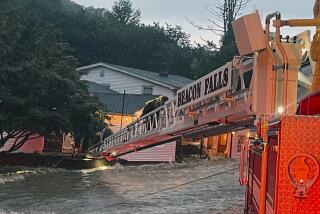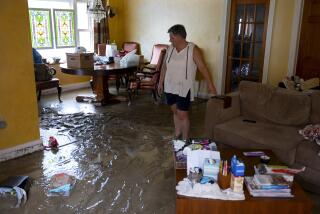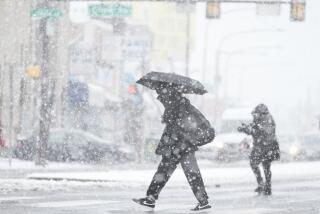In Sandy’s wake, gasoline keeps dwindling as temperatures drop
NEW YORK — Temperatures plummeted and tension soared in the Northeast as gasoline supplies continued to dwindle despite furious efforts to bring in fuel. Sandy’s death toll reached 100, and New York called off its famous marathon, despite the mayor’s protestations that it should have taken place as scheduled, as a symbol of resolve.
Government officials moved aggressively to combat the fuel shortage, a crucial hurdle to recovery and a threat to commuters, generators, trash trucks, taxis and rescue workers alike.
President Obama on Friday ordered the Energy Department to loan diesel oil from government reserves in Connecticut to emergency responders. Secretary of Homeland Security Janet Napolitano took the rare step of waiving 92-year-old rules for the delivery of petroleum products to Northeast ports, expediting shipments from the Gulf of Mexico.
PHOTOS: Sandy’s devastation on the East Coast
In New York, Gov. Andrew M. Cuomo waived tax and registration requirements on fuel distribution — and insisted that there was “no reason to panic.”
It was evident that millions did not agree.
Lines for fuel stretched for miles and for hours. Some drivers ran out of gas before they could reach the pumps. In Queens, a 35-year-old man was arrested after he lost patience, cut in line and pulled a .25-caliber pistol on motorists who complained. Airlines began taking the costly step of carrying extra fuel on planes.
VIDEOS: East Coast hit by deadly storm
Authorities said gas availability might not return to normal for several more days.
“All this storm stuff is just driving me crazy,” said bartender Lindsay Benjamin, who walked two hours from her home in Queens to work in Manhattan. “The vibe is very nervous. A lot of people are temperamental.”
Five days after Sandy delivered a staggering blow to the most populous region in the United States and became one of the nation’s costliest natural disasters, there were some significant signs of recovery.
FULL COVERAGE: Super storm Sandy hammers Northeast
Most symbolically, the lights started coming on in pockets of Lower Manhattan, home to vital financial institutions and dense, lively neighborhoods. Crowds of residents erupted in cheers as power began coming back to about 100,000 customers in the East Village and Chelsea neighborhoods. Repairs were expected to continue throughout the southern tip of Manhattan this weekend.
The Holland Tunnel, a crucial conduit under the Hudson River connecting Manhattan with the west, also opened to buses Friday. And New Jersey Gov. Chris Christie reopened the 12 casinos in Atlantic City, the beachfront landmark that was just a few miles away from where the center of the storm struck land.
Still, nearly 4 million homes and business were still without power. Some far-flung areas, even some of New York’s immediate suburbs, could face another week of darkness and cold.
Napolitano, visiting the devastated borough of Staten Island, said the area directly affected by the storm was roughly the size of Europe, and called the electricity crisis the “fundamental issue” facing the region.
Gasoline tankers began trickling into the New York Harbor on Friday, but in New York, New Jersey and Connecticut, searching for gas became a way of life. Residents were glued to radio stations carrying live updates of gas station deliveries. Drivers running on fumes were forced to gamble on which station’s line to join.
“This has been a madhouse,” said Walt Must, 56, a lawyer from Toms River, N.J., as he waited for gas near the Garden State Parkway.
Ahead of him, 32-year-old Rob Vargas was waiting in his red Montero, using Facebook to tell friends the station had gas. Vargas said he had weathered severe hurricanes in his native Nicaragua, and thought he was prepared for Sandy. Now, he said, there were 15 family members sleeping in his two-bedroom apartment in Lakewood, N.J.
“It changes everything — your point of view, everything,” he said.
The region’s woes went far beyond the lack of gas.
In Lower Manhattan, some residents spent a fifth day walking up 10 or more flights of stairs to their apartments. Many toilets did not flush. Baths were rare. Though National Guard troops and others had dispensed hundreds of thousands of meals, some Manhattan residents were spotted Friday digging through a trash bin for food. The city’s celebrated, century-old subway system remained hobbled.
It did not help that temperatures had fallen precipitously and were expected to dip to near freezing this weekend. Worse, forecasters said a second storm could form off the Southeast coast early next week and wend its way to the Northeast. It would not be another Sandy — but even a garden-variety storm could bring wind, rain and snow to communities that were barely hanging on in the sunshine.
In an interview, New York Assemblywoman Nicole Malliotakis said half of Staten Island, home to nearly half a million people, remained without power. She represents the island’s east shore, where at least 19 people were killed by a ferocious tidal surge, most after ignoring mandatory evacuation orders. Survivors, Malliotakis said, are living without “the basics,” have little communication with the outside world and are tired to the bone.
“I’m physically exhausted — but I can’t sleep at night,” she said. “People have lost everything.”
A caustic debate had erupted in recent days after Mayor Michael R. Bloomberg had insisted that the New York City Marathon should proceed as scheduled. “We have to go on,” he said.
But many residents and government leaders called the decision irresponsible and indifferent, and the event was canceled Friday evening.
New Yorkers continued to pine for the restoration of the city’s subway system. No subway routes were available between Brooklyn and Manhattan.
Crews have pumped much of the floodwater out of stations and tunnels, but officials say it could still be several days or longer before full service is restored. Electronic signals, tracks, heating vents, public-address systems, fare-collection machines and lighting all need to be inspected for damage before the stations can be deemed fit for passengers and employees.
“Pumping water is the first step of many steps,” said Frank Jezycki, the system’s chief infrastructure officer.
Perhaps the most serious damage occurred at the South Ferry station, at the southern tip of Manhattan, where waves of floodwater smashed through barricades, ripped off chunks of the wall and rose 40 feet from the track bed to the mezzanine level, where passengers enter through turnstiles.
Crews have pumped about 15 feet of water out of the station, Jezycki said, but on Friday afternoon a murky brown pool about 25 feet deep still sat above the tracks, littered with debris and thick with the stench of fuel. The recently renovated station is one of the most important in the city, serving Wall Street and the city’s financial hub.
Sandy reached a grim milestone Friday when authorities raised the U.S. death toll from the storm to 100, on the heels of 71 killed in the Caribbean.
The Coast Guard called off the search for the captain of a three-masted sailing ship that sank off North Carolina as Sandy zeroed in on the coast. One crew member was killed and 15 rescued.
Rescue workers had been searching since Sunday for Robin Walbridge, captain of the HMS Bounty, which was built for the 1962 film “Mutiny on the Bounty.” Calling off a search, said Capt. Doug Cameron, the chief of incident response for the Coast Guard 5th District, “is one of the hardest decisions we have to make.”
Staff writers Cindy Carcamo, Richard Simon, Michael Muskal and Molly Hennessy-Fiske contributed to this report.
More to Read
Sign up for Essential California
The most important California stories and recommendations in your inbox every morning.
You may occasionally receive promotional content from the Los Angeles Times.













